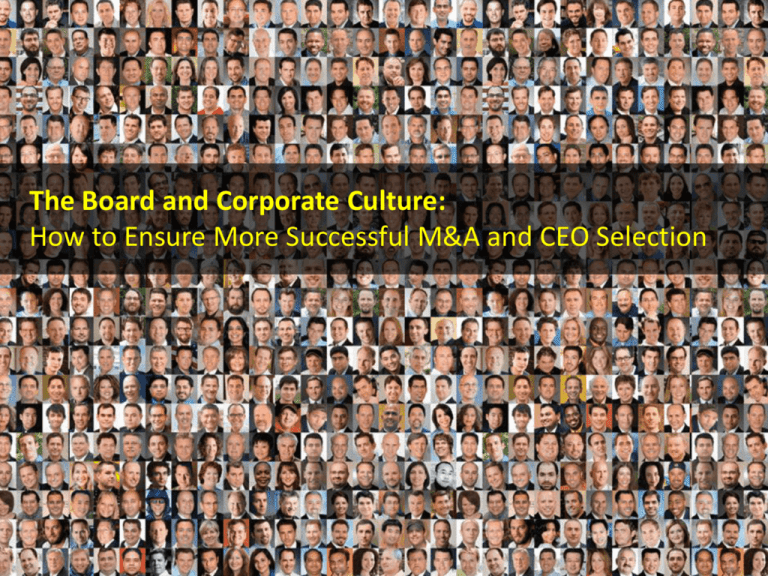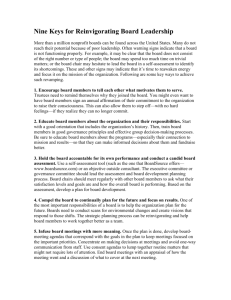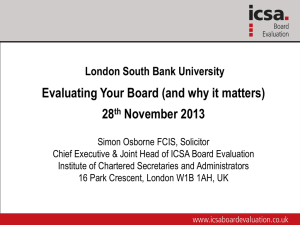Directors and Boards Makovsky Webinar
advertisement

The Board and Corporate Culture: How to Ensure More Successful M&A and CEO Selection Format • Introduction by Jim Kristie, Editor & Associate Publisher, Directors & Boards • Time for questions (enter them from your computer) during and after the presentation • 60 minutes • Presentation will be emailed to all participants after the webinar. 2 • • • • Speakers Andrew Goldberg is Executive Vice President and head of Makovsky Corporate Advisors, which provides change management and reputation enhancement solutions. He has advised major corporations for over two decades, in some of the most challenging matters: mergers and post-merger integration, management and structural realignment within corporations, CEO and C-level succession, governance issues and major litigation. In addition, he has been involved in the realignment of marketing and brand strategies in most regions. Philip R. Lochner, Jr. currently serves on the Boards of Directors of the following public companies: CLARCOR Inc. (which is in the filtration and packaging businesses), CMS Energy Corporation, where he is the Presiding Director (an electric and gas utility), Crane Co. (a diversified manufacturer) and Gentiva Health Services (a home healthcare and hospice company). He has previously served or currently serves as Chairman of the Audit, Compensation, Compliance, Nominating, Governance and Litigation Committees of boards of public companies. Mr. Lochner has previously served as a member of the Board of Governors of the National Association of Securities Dealers and of the American Stock Exchange. He has also served as a member of the Board of Advisors of Republic N.Y. Corp., a New York banking corporation, and as a member of the Boards of Directors of, among others, American Television and Communications Corporation (a telecommunications company), Apria Healthcare Group (a healthcare company), Brooklyn Bancorp (a bank) and Gtech Holdings (an IT company), all of which were public companies when he served. In addition, Mr. Lochner joined and served on the board of Adelphia Communications after that company filed for bankruptcy in Chapter 11. Warren L. Batts is Chairman of the Board, Methode Electronics, Inc. (NYSE: MEI) and the Cook County Helath & Hospital System. Adjunct Professor University of Chicago Graduate School of Business where he teaches Corporate Governance and First Time General Management. Retired Chairman and CEO of Premark Intl. Inc. and Tupperware; earlier served as CEO of two other companies. Retired director of Allstate, Cooper Industries, Sears, and Sprint, where he was either chairman or a member of the compensation committees, in addition to having served on the boards of 12 other public companies. Also a retired director of the Art Institute of Chicago, NACD, Northwestern University, and Children’s Memorial Hospital. Past chairman of Advisory Board of Georgia Tech, Children’s Memorial Hospital, National Association of Manufacturers and the School of the Art Institute of Chicago; and past member of The Business Roundtable. Jim Kristie is editor and associate publisher of Directors & Boards, the only major independently-owned journal of corporate governance thought leadership in North America. He is the longest-tenured editor (at 30 years) serving this field. In addition to his editorial duties, Jim teaches journalism at Temple University. Why Culture is Critical What Do We Mean By “Corporate Culture?” Corporate Culture: rules, behaviors and ideas, which promote collaboration and conflict, ethics and fairness, and the achievement of merit and the assignment of reward Products of Culture: new ideas, products and processes Most Companies die young; only 10% of companies survive 40+ years Adaptive, energized cultures promote longevity Most companies fail from within, as cultures lose their adaptability Management often in denial when culture is collapsing Few succeed in transforming culture Who Made it? Who Didn’t? Skin of Their Teeth At Risk Boards Need to Step In… Growth Transformation Flatline Maturation Growth Time Before organizations flat line! Culture: Boards Must Be Ahead of Management Culture more than “tone;” transcends ethics and social optics Eroding culture eats away at shareholder value Cultures can deteriorate at the biggest brands: HP, Yahoo!, RIM, MF, Goldman, Newscorp, Walmart Challenges Problem: Cultural symptoms often ignored by Management Result: Boards discover culture issues through weak performance Remedy: Early, accurate diagnosis via independent audit; spearheaded by culture committee Don’t Count On Warning What is surprising is that we are surprised Market liquidity and financial engineering often disguise terminal illness M&A: often used to bypass cultural gridlock • Results in two combined problem cultures Post Mortem Results: Toxic Cultures Shrinking innovation Declining IP Morale and ethical issues Disengaged C-Level Dis-intermediated innovators Risks flare up throughout the organization Culture Eats Strategy Boards tend to review strategies, not ability to implement The best strategies are destroyed by failing cultures Management often misreads culture’s ability to enable strategy Need to get “underneath the hood” Culture Eats M&A Cultural due diligence is essential for a successful merger Cultural factors don’t show up on a balance sheet; but can be inferred by performance metrics Examples: Ideal characteristics for healthy culture Where Employees Feel Engaged Efficient yet flexible Focused while also innovative Strategic and supportive Driven & disciplined yet open-minded (listener) and spontaneous Hierarchical yet collaborative Recognition-based (rational) while also empathetic (emotional) Engaged Cultures Drive Performance Metrics* Culture Focused Companies Hierarchical Focused Companies Revenue growth 682% 166% Employment Growth 282% 36% Share Price Growth 901% 74% Net Income Growth 756 % 1% *Harvard analysis over 20 years But most companies aren’t engaged Performance Correlates with Culture Culture 3%: “self governance” guided by core principles, values, trust 43%: culture is top down/ command and control Financial Response Q: How would you gauge your company’s financial performance relative to its competitors? Percentage who responded “Much Above Average” or “Above Average”: 54%: skilled leadership but communication still top down/ carrot and stick model * Based On a Boston Research Group Study 92% Self-Governance 77% Informed Acquiescence 52% Blind Obedience A cultural diagnostic for Boards of Directors Boards Need Transparency Lead directors need to go beyond assessment of tone Frank dialogue with CEO: organizational and people issues in critical business functions Need to request an outside perspective on organizational performance Boards Need Adequate Tools Independent culture audit: once or twice yearly Examining cultural metrics: values vs. performance But what tools to use? Organizational Network Analysis for Boards Organizational Network Analysis ONA : A well recognized process of mapping organizational strengths and weaknesses - applied to variables such as collaboration, knowledge management, post-merger-integration, organizational changes and innovation A sound culture exists where formal and informal organizations align: An illustration Formal organization and structures A healthy culture requires: A good fit between strategic goals, incentive systems and performance measures Performance Incentives Strategic focus Governance Projects Process Informal organization Perfomance measures are fair and transparent Employees awarded highest performance ratings are viewed as true top performers by peers Distance Availability Competencies Other barriers Results Trust Energy © I N N O V I S O R Network analysis quantifies intangible aspects of an organization in an unbiased form Network Analysis offers : – Match: formal and informal – Direct feedback – Identify employees who are seen as top performers by their peers collaborative patterns: size of circle indicates how many times an employee has been mentioned by peers as someone sought out for advice © I N N O V I S O R Diagnosing cultural health … an upward sloping plot indicates a strong fit between manager and employee perception of star performance – strong performance is fairly rewarded ” Rating-performers” ”True high-performers” Median score Official employee performance score … a downward slope indicates problems: employees do not feel true performance is properly rewarded ”Hidden stars” ”Others” Median score Shape = Hierarchy Peer performance score (Trust and professional contribution) © I N N O V I S O R Lessons from the cultural crossroads CEO Selection and Retention Traditionally based on financial acumen; ignored culture Cultural compatibility and mobilization are critical for building healthy companies Leaders with track record of building sustainable cultures are optimal choices for CEO A Call for Board Action Warning signs are hard to read Timely renewal is tough Boards have an active responsibility to safeguard cultural health Leadership, access, transparency and the right tools are essential for board success Thank you! Questions?





